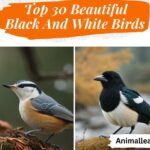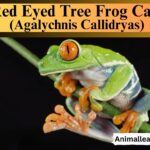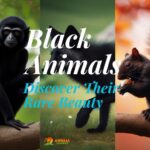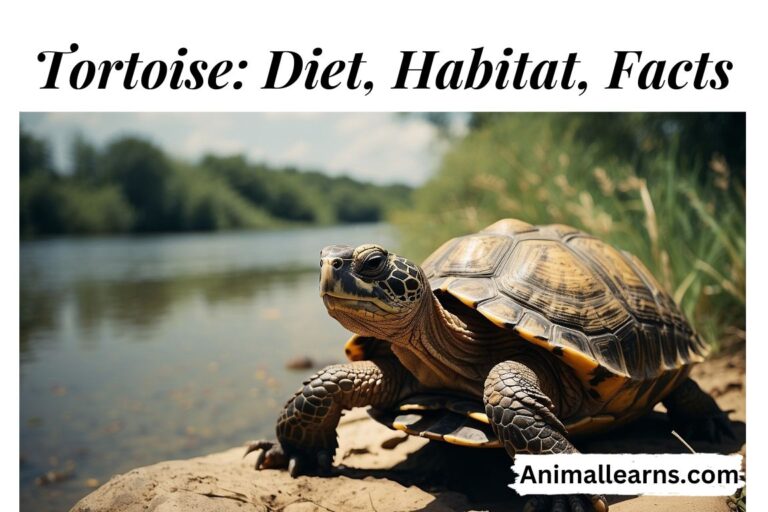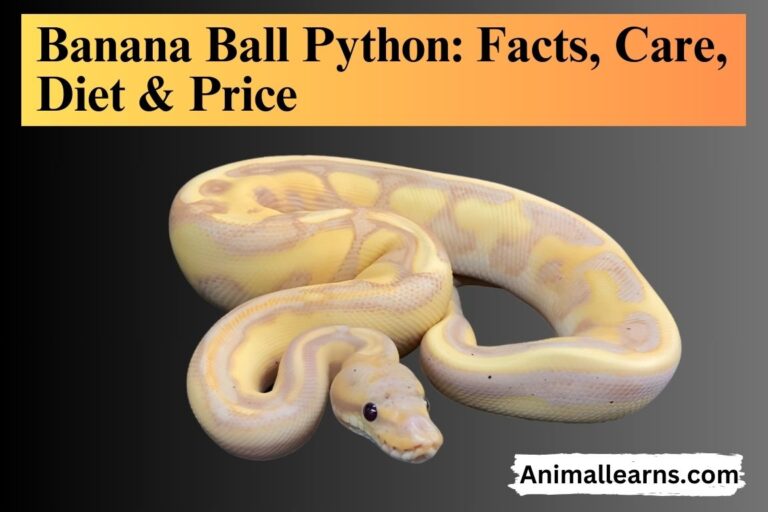Red-Eyed Crocodile Skink Care, Diet & Habitat

| Feature | Description |
|---|---|
| Scientific Name | Tribolonotus gracilis |
| Common Name | Red-eyed crocodile skink |
| Size | Adults typically reach 6-8 inches (15-20 cm) in length |
| Weight | 1.3 to 1.6 ounces (37-45 grams) |
| Appearance | Dark brown to black dorsally and laterally, with a yellowish, cream-colored underbelly. Distinctive bright red ring around the eyes. Crocodile-like scales on the back. |
| Habitat | Tropical rainforests of New Guinea |
| Diet | Insectivores, consuming a variety of insects like fruit flies, small crickets, and mealworms |
| Activity | Diurnal, active during the day |
| Lifespan | 10-15 years in captivity |
| Conservation Status | Least Concern (LC) |
| Social Behavior | Solitary |
| Reproduction | Viviparous, giving birth to live young |
| Clutch Size | One egg at a time |
| Incubation Period | 60-90 days |
| Sexual Maturity | 3-4 years |
Native to New Guinea, red-eyed crocodile skink is tiny terrestrial lizards. Due to their nocturnal nature, these skinks are mostly active at night. They hunt nocturnal insects during this time since they are insectivores. Red-eyed crocodiles are small terrestrial lizards that are native to New Guinea.
Though they have also been seen on coconut farms, they often reside amid the copious amounts of leaf litter that cover the tropical forest floor.
They live among the abundant amounts of leaf litter that cover the tropical forest floor, yet they have also been spotted on coconut farms. These skinks are primarily active at night because they are nocturnal animals. Because they are insectivores, they hunt nocturnal insects at this period.
A distinctive-looking species of skink that is occasionally maintained as an exotic pet is the red-eyed skink. It is indigenous to the tropical rainforest of New Guinea. Nelly de Rooij gave the first description of it in 1909.
Appearance
Contents

An intriguing group of lizards distinguished by their unusual look are crocodiles. Their enormous, spiky, triangular scales, which resemble crocodiles, are the reason behind their name. The skinks seem highly armored thanks to their scales, which also serve to shield them from predators.
The characteristic red ring around the eyes of these reptiles is another telltale sign. Adult crocodile-skinks grow to a maximum length of 8–10 cm (3–4 inches), making them comparatively tiny lizards. They inhabit a range of environments, such as wetlands, grasslands, and woodlands.
As insectivores, crocodile-skinks mostly consume beetles, termites, and ants. They have also been observed to consume berries and little fruits.
Habits and Lifestyle
Reptiles with a semi-fossorial lifestyle, are terrestrial. With the exception of moms and their children, they are highly solitary and prefer to be by themselves. Throughout the day, they are active.
Although they are skilled climbers, red-eyed crocodiles prefer to spend their time among the leaf litter found on the forest floor. They won’t ascend to the top of tree canopies; instead, they will stay on low-lying branches and fallen logs. They swim rather well as well.
One of the rare skink species that can vocalize in times of distress is the Red-eyed Crocodiles skink. They have a tendency to freeze in fear and have even been known to “play dead” when touched.
Physical Characteristics
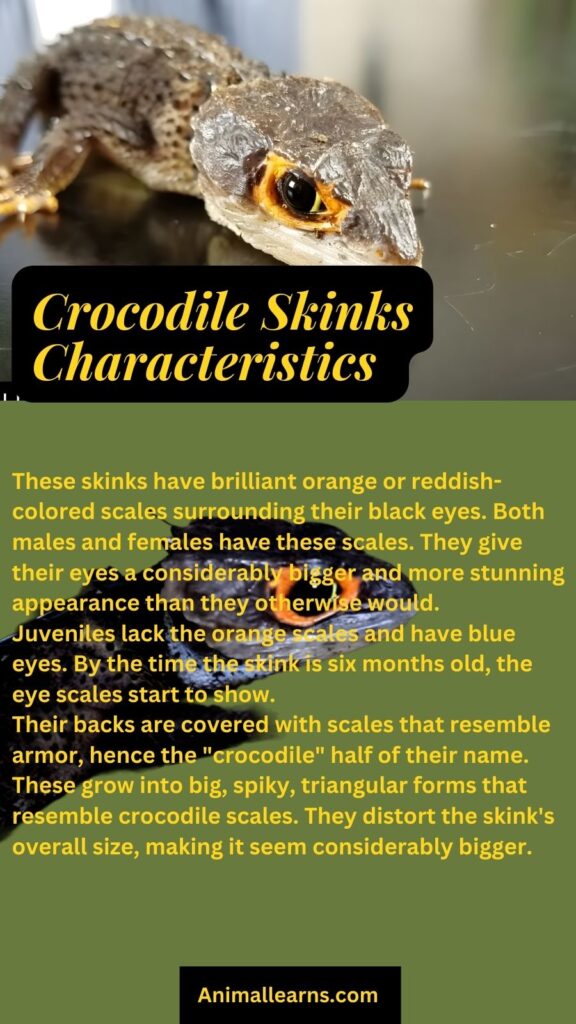
The red scales surrounding its eyes and the crocodile-like scales on its back are the two characteristics that make the red-eyed crocodiles skink most immediately recognizable. These skinks have brilliant orange or reddish-colored scales surrounding their black eyes. Both males and females have these scales.
They give their eyes a considerably bigger and more stunning appearance than they otherwise would. Juveniles lack the orange scales and have blue eyes. By the time the skink is six months old, the eye scales start to show.
Their backs are covered with scales that resemble armor, hence the “crocodile” half of their name. These grow into big, spiky, triangular forms that resemble crocodile scales. They distort the skink’s overall size, making it seem considerably bigger.
The limbs and tops of the bodies are uniformly colored black or brown in both sexes. They have cream or yellow undersides.
You can tell the men from the females by two characteristics. Large blue-grey pores can be found on the toes of the hind foot of males. Additionally, they have a rectangular area on their stomachs where their umbilical cord is connected, covered in larger, orange-tinted scales.
Neither of these characteristics is seen in females. They can live in captivity for more than ten years if given proper care.
Diet and Nutrition
These are insectivores, insects make up the majority of their food. They usually consume a wide range of insects in the wild, such as mealworms, roaches, crickets, earthworms, and waxworms. On rare occasions, they could also consume berries and tiny fruits.
These Crocodiles kept in captivity can be given a range of insect diets that are sold commercially. Fresh fruits and vegetables, as well as powdered calcium and vitamin D3, should be included to these diets.
Here is a table of the recommended diet:
| Age | Feeding Frequency | Insects | Supplements |
| Juvenile | Daily | Crickets, roaches, mealworms, earthworms, waxworms | Calcium and vitamin D3 powder daily |
| Adult | Every other day | Crickets, roaches, mealworms, earthworms, waxworms | Calcium and vitamin D3 powder every other day |
Mating

They usually fight each other during the breeding season in an attempt to attract females, while it is uncertain how they mate. The female lays one egg at a time every nine to ten weeks; she can deposit up to ten eggs annually.
Red-eyed crocodiles typically establish mother-child family groupings once their young hatch. The white pads, or pores, on the skinks’ rear foot are indicative of their gender since only the males have them.
Typically, males reach reproductive maturity at the age of three, while females reach maturity at the age of four to five.
Population
The vast range of their habitat and secretive character make it difficult to estimate the population of crocodile skink. They are, nonetheless, regarded as common in New Guinea.
The IUCN does not officially categorize the species as threatened, and there is no evidence to suggest that the population is diminishing.
The following are some variables that may have an impact on these populations:
Loss of habitat: Tropical rainforests, where they are mostly located, are being removed for development and cultivation. The loss of habitat may cause population fragmentation and make it more challenging for individuals to locate resources and partners.
The changing climate: Crocodile skinks may suffer as a result of climate change. The range of crocodile skinks’ acceptable habitat may get smaller as temperatures rise. Additionally, as insects are the main food supply for crocodile skinks, variations in precipitation patterns may have an impact on the quantity of insects.
Disease: Epidemics have the potential to wipe out populations of crocodile skinks. Numerous illnesses, including as salmonellosis and cryptosporidiosis, can affect crocodile skinks. In populations, these illnesses can spread swiftly, particularly in cases when animals are under stress or hungry.
Are Red-Eyed Crocodile Skink Friendly?
When touched by people, they typically experience extreme stress. It’s not advisable to communicate with them frequently.
When anything frightens them, they often go absolutely still. If they’re scared enough, they may even pass out and pretend to be dead.
It is especially hard to interact with the females after they lay an egg. Compared to most lizards, the females of this species are far more protective of their eggs. They only lay one at a time, covering the egg entirely with their body thereafter. Any disruption will result in them fiercely defending it with biting and chirping.
Are Crocodile Skink Good Pets?
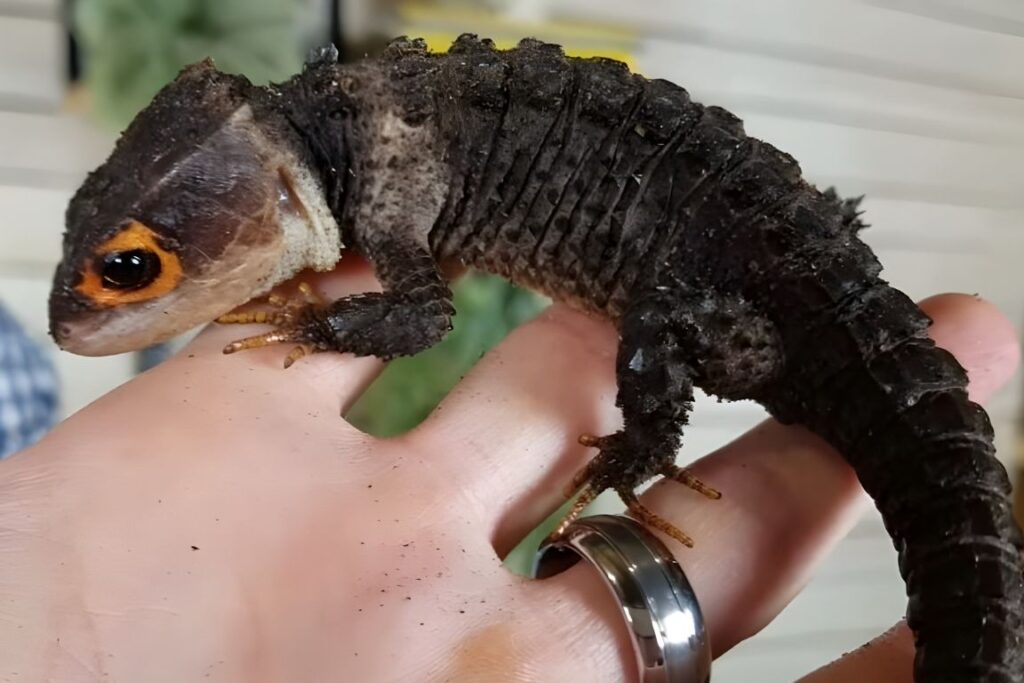
Even when raised in captivity, it’s unclear how successfully crocodiles (skinks) adjust to their new home, despite the fact that some people prefer to keep them as pets. According to a number of accounts, they can be extremely timid, uneasy in social situations, and uneasy when handled.
Nonetheless, the species has a respectable 5- to 6-year lifetime, little UVB needs, and appears to be tolerant to a broad range of insects.
Large terrariums with lots of hiding spots are necessary for sking to avoid prying eyes during the day. Even though many animals are more active at night, they nevertheless find it unsettling to be observed.
The majority of these species prefer temperatures between a pleasant 75 and 80 degrees, however cages must be kept at extremely high humidity levels.
Red-Eyed Crocodiles-Skink Health Concerns
Health Concerns for Red-Eyed Crocodile Skinks
They are frequently afflicted by three primary health issues:
Illness Of The Respiratory Tract: Breathing difficulties and drainage from the nose or eyes are warning signs. It could be brought on by an issue with the habitat.
Gastrointestinal Diseases: Weight loss and watery stool are symptoms. A food issue or bacterial infection might be the culprit.
Bone Disease Caused By Metabolism: Low calcium levels are the source of this, which can result in skeletal abnormalities, fractured bones, and even death.
For the greatest medical advice, speak with a veterinarian who has experience with skinks. Occasionally making little adjustments to your pet’s food or lighting will be sufficient to get them back to optimal health.
Basic Red-Eyed Crocodile Skink Care
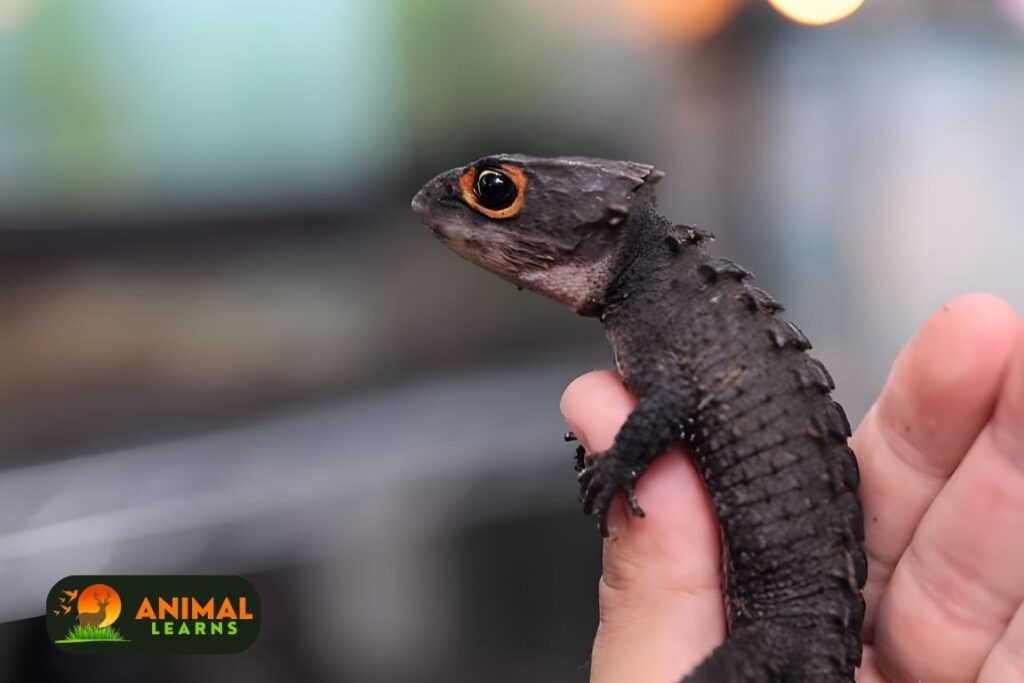
A minimum of 15-gallon tank is required for one skink. This has to be positioned with more horizontal than vertical space. For optimal ventilation, a mesh cover is also required. Just be certain that the lid fits securely; else, your cunning skink could escape.
It is possible to house a male and a female red-eyed crocodile skink in the same enclosure. The tank’s limited resources will be contested by skinks of the same sex. If you have two, the tank should also be somewhat larger.
The following are additional crucial information for your home habitat:
- A customized concealing box for a confined humid region may be purchased, and you can spritz the enclosure two or three times a day to keep the humidity between 70% and 90%.
- Plants, pebbles, logs, and bark strips should all be placed throughout the enclosure; however, avoid packing it too full, since they prefer to roam free.
- To allow them to burrow, keep the substrate 2 to 3 inches thick. Safe substrates include bedding made of paper, coconut fiber, or cypress mulch combined with sphagnum bark.
- Assign a range of daily temperatures: there should be a cold area between 72 and 75 degrees Fahrenheit and a warm area around 82 degrees Fahrenheit.
Conclusion
In conclusion, the crocodile skink is an amazing animal with a distinctive look and fascinating activity. They are distinguished from other lizards by their burrowing behavior, armor-like scales, and brilliant red eyes.
As insectivores, they are crucial to regulating insect populations and preserving the environmental balance of their rainforests. Although they are generally laid-back captives, prospective owners should carefully evaluate the special care needs they have to guarantee their well-being while in captivity.
FAQs
What are crocodile skinks?
A family of lizards indigenous to New Guinea are called crocodile skinks. Their enormous, spiky, triangular scales, which resemble crocodiles, are the reason behind their name. Adults grow to a maximum length of 8–10 cm (3–4 inches), making them comparatively tiny lizards. They inhabit a range of environments, such as wetlands, grasslands, and woodlands.
What do crocodile-skinks eat?
They are insectivores, insects make up the majority of their food. They usually consume a wide range of insects in the wild, such as mealworms, roaches, crickets, earthworms, and waxworms. On rare occasions, they could also consume berries and tiny fruits.
How do crocodile skinks reproduce?
As oviparous animals, they lay eggs. Usually, females lay two to four eggs at a time, which hatch after around 2 months. At the age of two, they attain sexual maturity.
What are the threats to crocodile skinks?
Loss of habitat and climate change are the two biggest dangers to these animals. Deforestation and urbanization are the main causes of habitat loss since they are eradicating their natural environment. The alteration of temperature and precipitation patterns brought about by climate change poses a hazard to crocodile skink survival.
Are they good pets?
Experienced reptile keepers may find crocodile skinks to be suitable companions. Although they don’t need much care, they do need a certain habitat, such as a warm, damp cage with lots of hiding spots. Being gregarious animals, they thrive in groups or couples.


